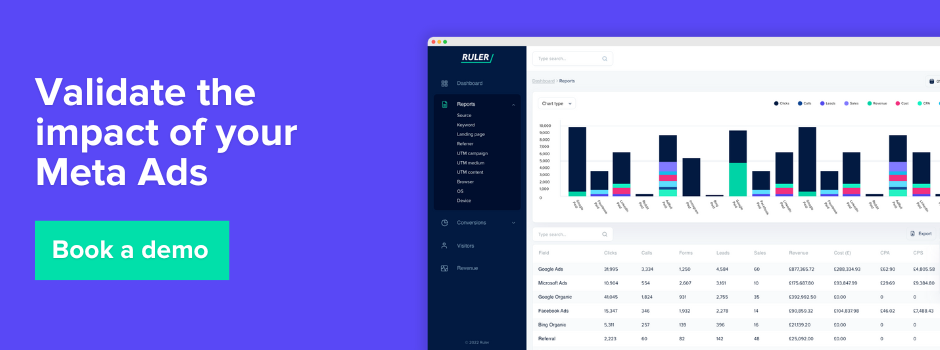We dive into Facebook offline conversions and show you an easier way to send your data to the ad platform for better reporting and smarter targeting.
There are some businesses that only make sales online.
Take Amazon, for example. Aside from some of its acquired properties, 100% of Amazon’s consumer sales happen on its website.
But for most businesses, that’s not the case. Whether you’re running a retail shop, a law firm, or a B2B company, chances are a good chunk of your sales happen offline—whether in person, over the phone, or at a meeting.
If your business relies on offline interactions to finalise sales, tracking these conversions properly is essential. Facebook offline conversions help bridge the gap between digital marketing and real-world results.
In this post, we’ll explore how they work, why they matter, and where there may be gaps to fill.
💡 Pro Tip
Ruler keeps tabs on every click ID, tracking online actions that lead to offline conversions—like calls, demos, and meetings. It uses multi-touch attribution to give you a full picture of the customer journey. Then, it syncs all that data with your CRM and sends key updates—like when leads become MQLs or SQLs—back to Meta. This helps Meta use your CRM insights to automatically run campaigns that target prospects who are more likely to convert.
Book a demo to see how it all links together
Meta’s Offline Conversions tool helps businesses track sales and actions that happen in the real world but were influenced by Facebook ads.
Whether it’s a phone call, an in-store purchase, or someone signing up at an event, these offline conversions give you a clearer picture of how your ads are performing beyond the digital space.
Since standard tracking tools like the Facebook Pixel can only follow online activity, offline conversion tracking fills in the gaps. It lets you report real-world events back to Facebook, ensuring your data is more accurate and your ad performance is measured properly.
With this insight, you can see exactly which digital touchpoints led to offline sales, helping you optimise your campaigns for even better results.
Facebook doesn’t automatically know if someone books an appointment or makes a purchase offline—but you can make sure it does by sending this data as offline conversion events.
The good news is that this process can mostly be automated, especially if you’re already using a CRM, accounting software, or a point-of-sale (POS) system to track your clients.
All you need to do is connect this data to Facebook’s Events Manager, allowing it to improve the accuracy of your ad performance tracking.
In the next section, we’ll walk you through the setup step by step.
Before you set up Facebook offline conversions, you need offline conversion data to send in the first place.
Chances are, you’re already tracking this in some way—whether it’s in a spreadsheet, a CRM, or a POS system.
Even if it’s a basic setup, that’s a solid start. You’ll just need to format it so Facebook can process it properly—but we’ll get to that later.
We prefer to use a first-party data platform like Ruler, which tracks the entire customer journey at a visitor level. It captures key details like marketing sources, UTM tags, page views, click IDs, and cookie IDs.
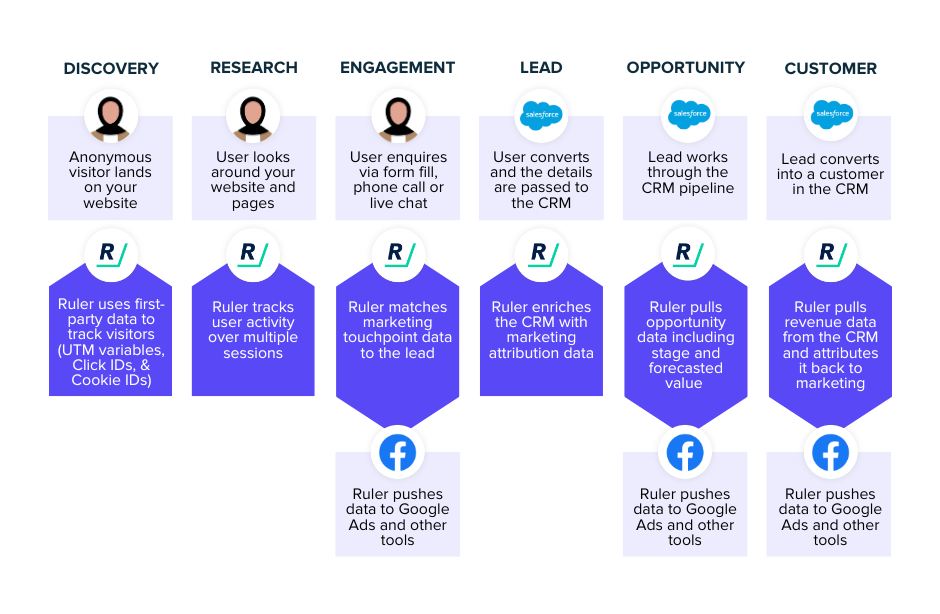
When a visitor converts offline—like calling in or doing an in-person demo after filling out a form or using a tracked phone number—Ruler connects their online interactions with their conversion data.
As leads turn into paying customers, Ruler feeds revenue data back into its dashboard, making it easier to track ROI and ROAS.
The big advantage of using a first-party data platform over other methods is visibility.
Customer journeys are complex, with multiple touchpoints influencing conversions. Facebook often plays a more significant role than many businesses realise.
A platform like Ruler helps you visualise Facebook’s impact and track how it contributes to essential conversions.
Also, it ensures that the data you send back is high quality because it’s based on leads that have already passed key stages in your funnel.
Once you’ve got your offline conversion data, you can either upload it manually to Meta or send it automatically via the API—we’ll cover both options shortly.
Now that your offline conversion data is ready, it’s time to bring it into Facebook. This will give you access to more accurate reporting and better custom and lookalike audiences for targeting.
To get started, open Facebook Events Manager by heading to Meta Business Suite → All tools → Events Manager.
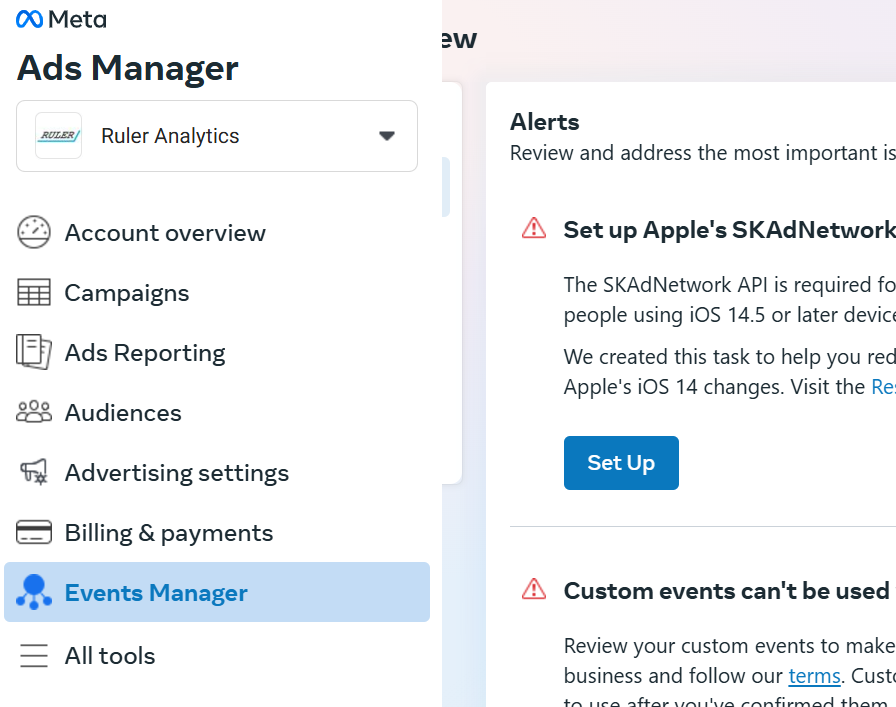
Click the green plus sign and select Connect data sources.

Choose Offline, then click Connect.
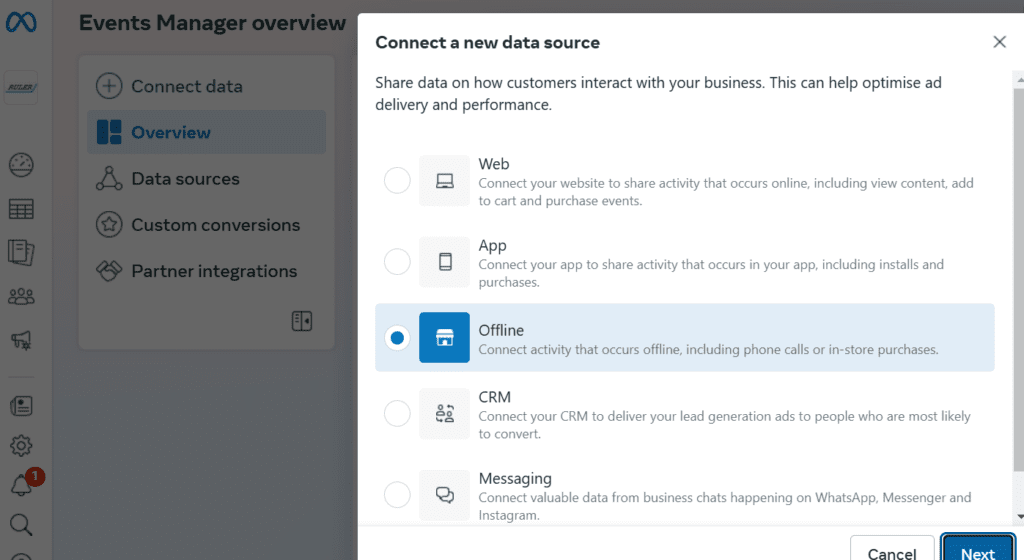
Click Create new data set and enter a name for it—make sure it’s something unique so you can easily find it later when setting up ads or custom audiences.
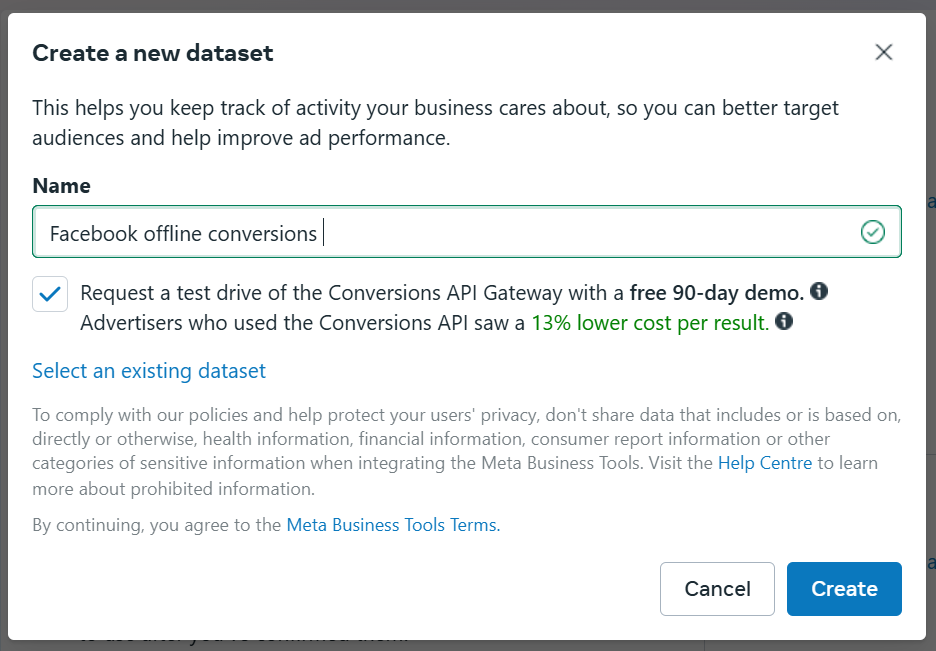
If you have a website, you can enter your URL to check if you can connect your data using a partner like Shopify, WordPress, or WooCommerce. If you don’t have a website, just tick the box that says “I don’t have a website”.
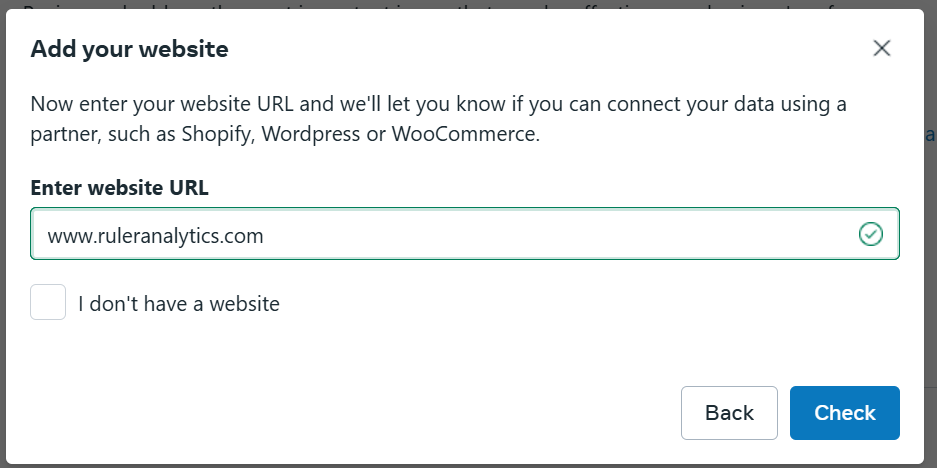
For now, skip this step and move forward.
Once your dataset is created, you’ll be able to view event data by clicking on your dataset ID in Events Manager.
Now it’s time to upload your offline event data into Facebook. There are a few different ways to do this, but the most common ways are to:
We’ll start with the most basic, which is to manually upload via CSV.
Open Events Manager and select the account you want to use. Click the Data sources icon.
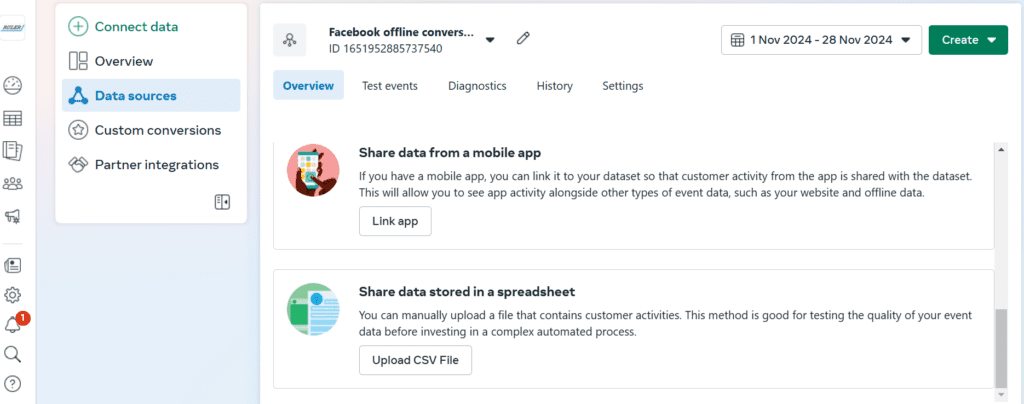
Select the name and ID of the dataset you want to upload offline events to.
Click Upload events.
Drag and drop your data file into the upload box or select CSV file to add it from your desktop.
Before uploading, make sure your data is formatted correctly. Meta provides templates to help with this—just click View examples under Customer details, Event time, or Event details, or download the example CSV file.
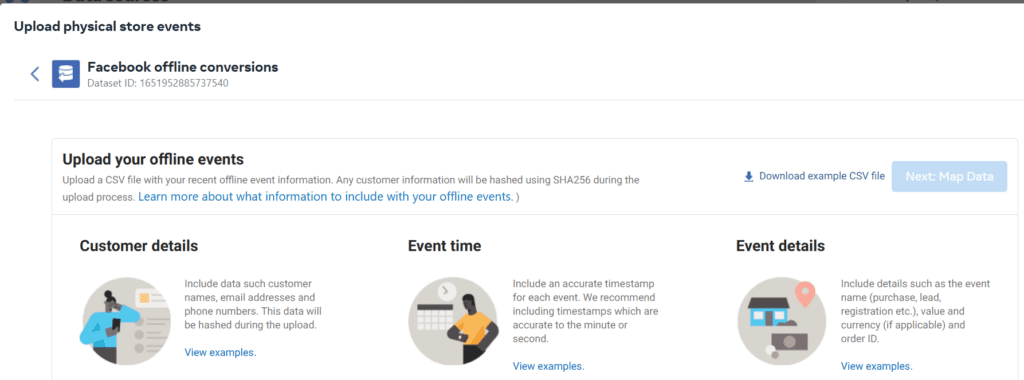
Once your data is ready, click Next: Map data. Facebook will review a sample of your file and automatically detect data types for each column.
Check each column to ensure everything is mapped correctly. If anything is missing or incorrectly formatted, hover over the column header, click the pencil icon, and select the right data type from the dropdown.
Click Next: Review to check how many rows are ready to be uploaded, your estimated match rate, and any warnings. If needed, click Back to adjust your file before finalising the upload.
When everything looks good, click Start upload.
The time it takes to process your data depends on the file size. Once it’s complete, you’ll see the number of uploaded or skipped rows.
After uploading, you’ll be able to:
If you’re using a first-party tool like Ruler, you get even more benefits:
Basically, with offline conversions properly set up, you’ll have a much clearer understanding of how your Facebook ads contribute to real-world results.
Meta has announced that the Offline Conversions API will be phased out in 2025, but you can switch to the Conversions API to send offline event data to Meta Ads.
Here’s how the process typically works:
If you’re using a tool like Ruler, the good news is that it connects to Facebook’s API automatically. With Ruler, here are some of the events that get sent to Meta:
| Event Type | Offline Event Name |
| New Phone Call | Ruler Phone Call |
| New Opportunity Stage | Ruler Opportunity (If you wish to send separate events per opportunity stage, you can create the event as per the stage name – please just update your account manager who can update your configuration) |
| New Revenue | Ruler Revenue |
All you need to do is provide your Offline Event Set ID, and Ruler will take care of the rest, making it easy to sync your offline data with Facebook’s Conversions API.
This streamlined process helps ensure your reporting stays up-to-date and connected with your Facebook ads.
To hit your team’s biggest goals and demonstrate the effectiveness of your marketing efforts, tracking conversions is essential. And that means not just tracking online actions, but also the conversions that happen offline—whether it’s a phone call with a sales rep or a face-to-face interaction at your office, store, or attraction.
By using Facebook offline conversions alongside a more advanced system like Ruler, you can easily track marketing’s impact on your business.
It helps you prove the ROI of your campaigns and show how the work your team does is not only indispensable but crucial to driving business growth.
If you need a hand setting up your offline conversion tracking, don’t hesitate to reach out. We’re here to help you optimise your approach and get the most out of your Facebook ads. Book a demo to get started.
